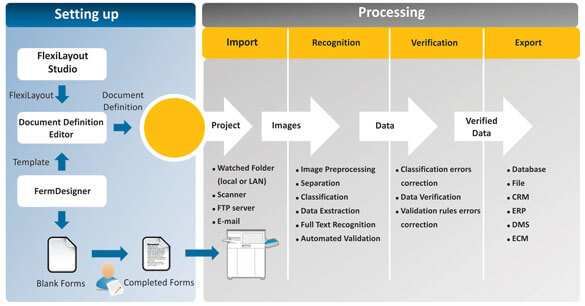
It is not hard to understand, the key to the thriving business – is process optimization and automation. We live in an extremely fast-changing world, where every time delay may lead to significant revenue loss.
This way, it is critical to use different software solutions to optimize business processes: let us have a closer look at the document workflow. Even today, many companies still write documents by hand and experience problems with the document digitization process.
Well, it is easy to realize, why the companies do so: it saves time – just in case not everyone has decent typing skills. For example, in Healthcare it is faster to fill the patient forms by hand and after that manually submit the data to the internal healthcare systems.
That manual process is not the easy one, but it can be easily optimized. The hospitals may use custom document digitization services that can handle the illegible hand-written text processing in the real-time. But hospitals are nonprofit entities, sponsored by the government.
Another great example: everyone knows Google Books – the project primary purpose of which is to digitize as many books as possible. Well, it takes a lot of resources to scan millions of books from various libraries. Anyway, Google is a huge corporation and can afford it.
- But what about medium and small businesses?
- Can they use document digitization software at the workplaces?
- Is there a ready-made and inexpensive solution?
Keep on reading, and in five minutes you will know everything about document digitization for the medium and small-sized businesses!
THE EVOLUTION OF DOCUMENT DIGITIZATION PROCESS
Everyone knows what digitization is, but we will spell the definition once again to ensure we are talking about the same thing.
Digitization is the process of making everything digital: converting information into digital format.
To understand the digitization process better, we should define another term – OCR.
Optical Character Recognition (OCR) – the number of computer science techniques that make it possible to convert different types of documents, such as scanned paper documents, PDF files or images captured by a digital camera into editable and searchable data.
Those two terms sound similar and a little bit confusing, right? Let’s discover the difference.
Under OCR we usually mean the typewritten text recognition. This way, traditional OCR is unable to process the handwritten text, because it is based on known glyph or character recognition. There are even scanners – physical devices, which are used for document scanning.
Modern digitization is entirely different from the OCR. Well, ten years ago the best way to digitize the document was to use the already mentioned scanner, until the day when machine learning and artificial neural networks appeared. Those technologies changed everything.
With the rise of machine learning, the OCR transformed to ICR – Intelligent Character Recognition. The main difference between OCR and ICR is the possibility to recognize handwritten text quickly and accurately.
ICR engines use a different approach to digitize documents – the core of the modern document digitization system is the artificial neural network. The best way to make it work – teach it with the already digitized data.
Imagine, there somewhere is a hospital with dozens of doctors in it. To make the document digitization software recognize your patient disease medical records, we should provide the hand-written document and manually digitized ones. After the successful learning, the artificial neural network will be able to recognize hand-written patient diseases data according to the doctors’ writing style.
We can also use Google or specific databases to find the sample data.
The more data artificial neural networks processes – the more accurate results it will provide.
The main problem is the lack of databases with the sample data. It makes the hand-written text processing quite expensive even for large enterprises. The market leaders collect the sample data for years, and that data makes their document digitization systems extremely accurate while processing the hand-written text.
DOCUMENT DIGITIZATION SYSTEM: FEATURES LIST
Document Digitization systems usually use two types of engines: OCR (traditional methods) or ICR (machine learning) – as their core.
Usually, digitization systems built upon OCR engines are used when there are strict budget limitations, and there is a known pool of document templates. Such systems (OCR) are inexpensive – starting from 5$ for a single user per month.
The systems that use ICR are more expensive than the previous ones. They use complex machine learning models and trained artificial neural networks that can handle the majority of the hand-written texts. As the ICR engines are complicated to develop, so the prices for the document digitization services or software based on ICR are calculated individually for every particular customer.
There are also hybrids that use machine learning for the text processing, but are not as smart as ICR engines are. Hybrids can accurately process the typed and cursive text, sometimes even “understand” the hand-written document. De-facto, hybrids are ICR engines, with the lack of data needed for complete model learning, but with the advantages of ICR: document structure determination, impressive processing performance, simplicity at scale, etc. The prices are mostly affordable and equal to the OCR-based systems.

We realized the main types of document digitization engines, we can discuss the additional functionality the document digitization system also provides to satisfy the regular customer.
Alongside with data extraction, the document digitizing systems offers data analysis. Under data analysis, we mean document structure determination, phone numbers, and email addresses investigation, legal information inquiry, etc.
The modern document digitization systems do not need human attention to analyze and extract data. The system can map the document content by itself according to the previous experience. Sure, the process starts with human mapping, but during the process, the engine “learns” to determine document patterns by itself.
This way, ICR and hybrid document digitization systems are improving their performance during the long-term run.
Unfortunately, the majority of document digitization systems are not standalone. It means that they cannot be used without the internet. Such an approach has both pros and cons, let’s briefly discuss how document digitization software works.
Every document digitization system consists of several parts. Usually, these parts are scanning devices, processing engines, and storage drives.
In simple words:
– The device that scans the text
– The software that processes text, extracts, and analyses the data
– The drive that is used as the storage for processed data
These devices depend on the document digitization system and the engine help to perform the text processing (OCR or ICR).
OCR engines are usually tiny: require low computing power and storage capacity – but inaccurate. Document digitization systems based on OCR do not need additional hosting, these ways those systems can be hosted on the single machine and be used with the peripheral device with ease.
ICR engines use entirely different architecture: there are several clients and the single server. As we already know, there is the neural network that powers ICR. So this network is usually hosted in the cloud. The cloud is maintained and tuned by the vendor.
The clients are the devices that send the scanned images to the cloud. The cloud processes the image and returns a response with the text.
The ICR approach is the most common today. The vendor has an opportunity to tune the machine learning model without interaction to the single client and updating its software, it leads to the quality improvement over time.
Unfortunately, client-server architecture requires the Internet connection for image transfer. This way data compression and encryption are critical as never before.
DOCUMENT DIGITIZATION AT THE WORKPLACES
Even several years ago document digitization systems were the complex and monstrous solutions used mostly by huge corporations like BMW, Deutsche Bank and Bank of America.
Now the situation has changed dramatically. Both OCR and ICR techniques are known, and the technologies are mostly affordable for every business. Moreover, there are a lot of companies that offer document digitization services.
Even better, with the rise of the smartphones, we may have ICR engines enabled in our mobile devices. All we need is to have an Android or iOS smartphone with a decent video camera.

For example, at Azati we are integrating the free mobile application for document digitization with a small maintenance fee.
Here are some of the application core features:
– Accurate and quick text scanning;
– Secure data processing;
– Ultra Reliable cloud data storage;
– Easy document management with QR codes.
The application is perfectly suitable for medium-sized and small businesses that care about cost optimization and want to get the best cost/quality ratio.
SUMMARY
It is not hard to understand what document digitization is. Now we know the evolution of the digitizing software, how it works and its main features. The provided information helps us to make better business decisions and cut down costs.
Sure, we can use document digitization software at the workplaces. There are a lot of different applications that both large corporations and small companies can use. The technology is affordable today for almost any company: from the hospital to the single insurance broker.
Is document digitization software worth a try? It is worth it.
By the way, some companies are wasting almost half of the working time (about 43%) for manual document digitization. Imagine the benefits that technology can provide to them. It is not only about significant cost reduction, but optimized business processes also make the company healthier by all means.

